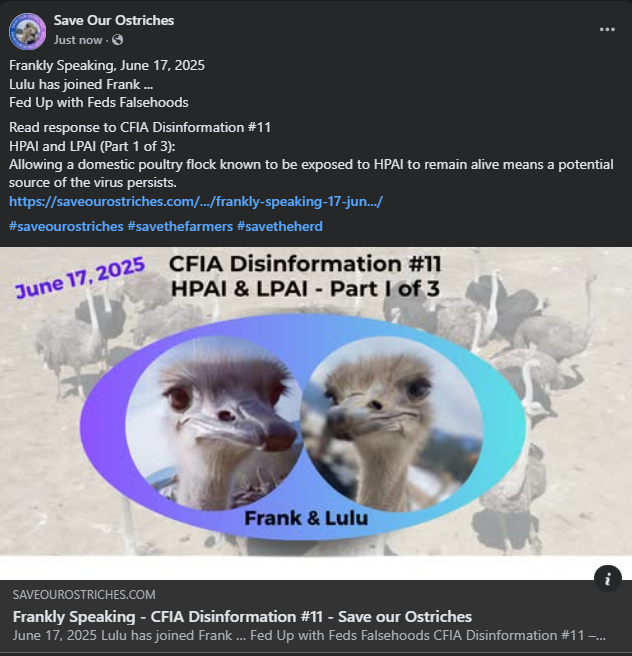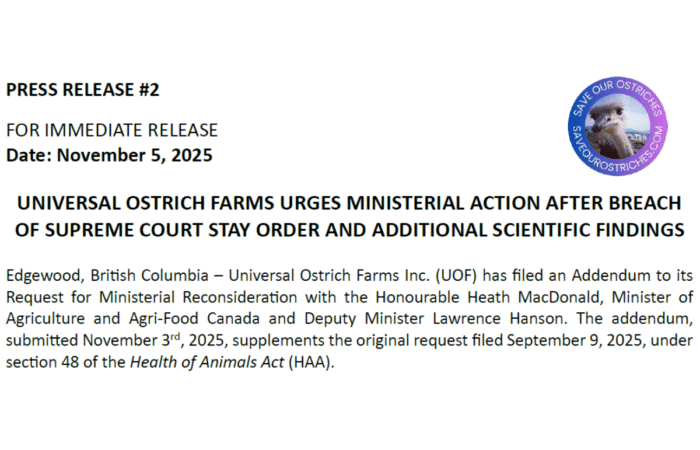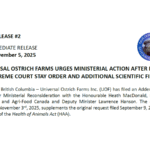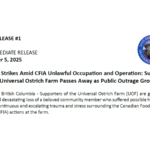June 17, 2025
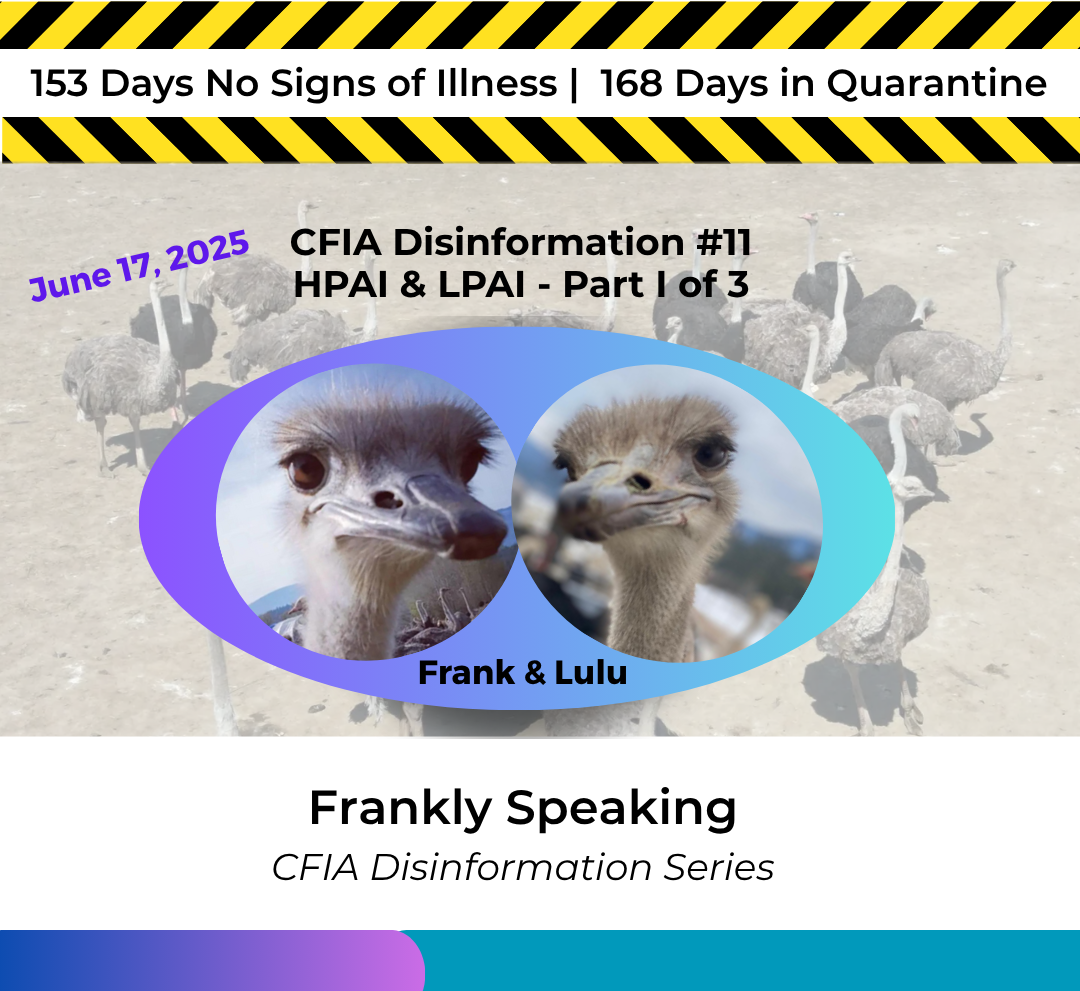
Lulu has joined Frank … Fed Up with Feds Falsehoods
CFIA Disinformation #11 Part 1 – HPAI and LPAI
Edgewood, BC – June 17, 2025
Disinformation Response to two CFIA Statements (May 31, 2025):
- Update on the CFIA’s actions at an HPAI infected premises at a BC ostrich farm
- CFIA’s basis for applying disease control measures at an avian influenza infected ostrich farm
Tune in regularly for Frankly Speaking episodes in the CFIA Disinformation series.
HPAI and LPAI (Part 1 of 3)
CFIA Disinformation #11 – HPAI and LPAI Part 1: Allowing a domestic poultry flock known to be exposed to HPAI to remain alive means a potential source of the virus persists.
The assertion that “Allowing a domestic poultry flock known to be exposed to Highly Pathogenic Avian Influenza (HPAI) to remain alive means a potential source of the virus persists” relies on a broad assumption that all HPAI exposures pose an ongoing risk, regardless of context or clinical outcomes. This generalization is scientifically questionable and, in the case of the ostrich flock at Universal Ostrich Farm (UOF), fundamentally contradicted by actual data and real-world evidence.
Understanding Avian Influenza
- Highly Pathogenic Avian Influenza (HPAI): Characterized by mortality rates exceeding 75% in infected poultry, typically within 2–4 days, necessitating strict control measures1
- Low Pathogenic Avian Influenza (LPAI): Results in mortality rates below 75%, often with mild symptoms and fewer restrictions.
- Hybrid Strains: Display traits of both HPAI and LPAI, complicating classification and often failing to meet HPAI’s high mortality threshold.
HPAI with very high mortality, often exceeding 75% within 2–4 days of infection (Capua & Alexander, 20091) was not observed in our flock, as only 15% died in with a 31-day time frame.
Clinical Reality at Universal Ostrich Farm
In the case of our ostrich flock, several critical facts challenge the presumption that these animals represent a continued threat. CFIA on record acknowledged the ostriches were different as seen in the Respondents Application court document Pg. 635 s.22: “Most ostriches infected with HPAI will survive the infection, recovering roughly within 2 weeks” 7.
The UOF ostrich flock challenges the assumption of persistent viral risk due to several key observations:
- Low Mortality: Only 15% of the flock died over a 31-day period, far below the 75% mortality expected for HPAI (Capua & Alexander, 20091).
- Natural Recovery: The Canadian Food Inspection Agency (CFIA) acknowledged that “most ostriches infected with HPAI will survive the infection, recovering roughly within 2 weeks” (Respondent’s Application, Pg. 635, s.22). The flock is now well beyond the 14-day incubation period for avian influenza (WHO, 20062).
- Resolution of Symptoms: Clinical symptoms resolved without intervention, indicating recovery.
- Low Virulence Confirmed: Viral sequencing by the CFIA Winnipeg Lab identified the strain as a hybrid with low-virulence characteristics, consistent with LPAI or a low-pathogenic HPAI variant.
- No Ongoing Transmission: No secondary transmission has been recorded on the farm or in nearby areas for over six months, with the last avian influenza case in British Columbia reported on January 11, 2025 (CFIA, 20256).
- Testing Limitations: CFIA prohibited, and continues to prohibit post-recovery testing of healthy birds, preventing confirmation of PCR-negative status or seropositivity, which could further validate recovery.
These data indicates that the UOF virus does not pose a continuing transmission threat, a condition that must be present for the claim of “viral persistence” to be valid.
Scientific Context
Scientific evidence supports that LPAI and low-virulence HPAI strains typically cause mild symptoms, low transmission rates, and high survival rates (Swayne, 20174). Once birds pass the acute phase, test PCR-negative (indicating no viral shedding), and develop antibodies (seropositive), they are no longer active sources of infection (Swayne, 20083). Recovered birds may even offer insights into natural immunity and protective responses against avian influenza (Swayne, 20174).
Conclusion
The claim of viral persistence in the UOF ostrich flock lacks empirical support. The low mortality, natural recovery, absence of secondary transmission, and low-virulence characteristics of the virus demonstrate that the flock does not pose a continuing threat. Blanket assumptions about HPAI risk fail to account for species-specific responses and real-world data. Policymakers and stakeholders should consider this evidence to ensure decisions are grounded in science, rather than generalized and poorly supported fear of viral persistence.
Table 1 Feature Differences of LPAI and HPAI
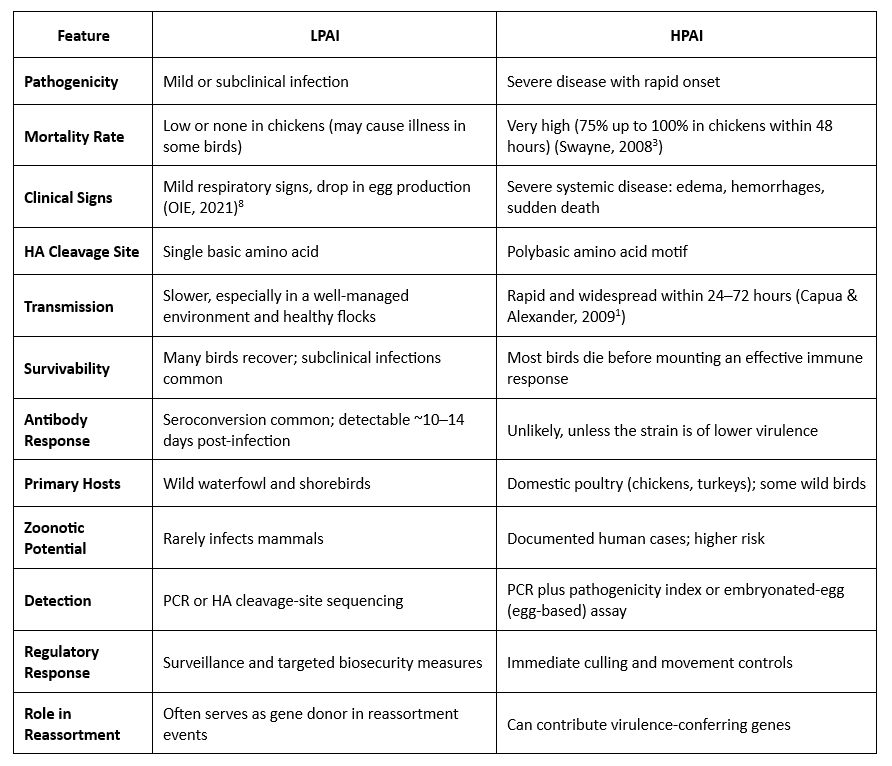
References
- Capua, I., & Alexander, D. J. (2009). Avian Influenza and Newcastle Disease: A Field and Laboratory Manual. Springer. https://link.springer.com/book/10.1007/978-88-470-0826-7
- World Health Organization (WHO). (2006). Avian influenza: Guidelines for control. (“bird flu”) – Fact sheet. https://afrohun.org/wp-content/uploads/2021/01/WHO-Avian-influenza-factsheet.pdf
- Swayne, D. E. (2008). Avian influenza control strategies. Avian Diseases, 52(3), 263–277 https://bioone.org/journals/avian-diseases/volume-52/issue-3/8229-012508-Reg.1/Using-Mean-Infectious-Dose-of-High–and-Low-Pathogenicity/10.1637/8229-012508-Reg.1.short
- Swayne, D. E. (2017). Avian Immunology (2nd ed.). Academic Press. Advances in avian influenza research. Journal of Poultry Science. https://onlinelibrary.wiley.com/doi/10.1002/9780813818634.ch19
- World Organization for Animal Health (WOAH) / OIE. (2021). Avian Influenza updates. https://www.woah.org/en/disease/avian-influenza/
- Canadian Food Inspection Agency (CFIA). (2025). Avian influenza updates (No BC outbreak since January 11, 2025) – https://inspection.canada.ca/en/animal-health/terrestrial-animals/diseases/reportable/avian-influenza/latest-bird-flu-situation/investigations-and-orders
- Respondents Application UOF vs CFIA Court Document – Pg. 635 – s.22 – “Most ostriches will recover in about 2 weeks)”
- OIE / World Organization for Animal Health (WOAH). (2021). Avian Influenza. https://www.woah.org/en/disease/avian-influenza/
Figure 1 What is the CFIA Lab Testing process? More details in the upcoming Part 2 of 3 post…
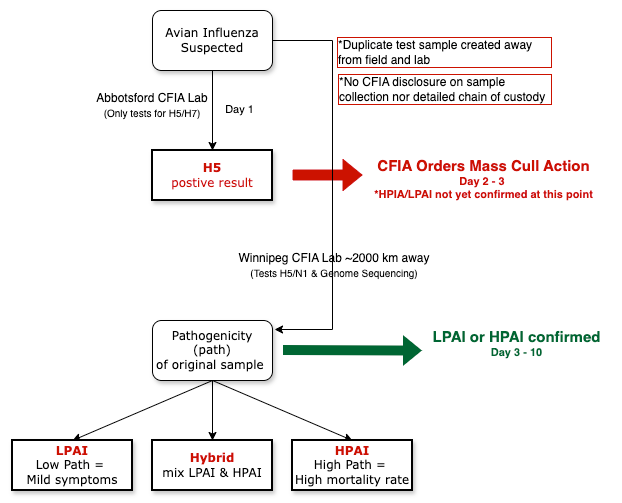
Stay tuned… this was the 1st of a 3-part HPAI and LPAI educative series in Frankly Speaking’s response to CFIA Disinformation.
Media Contact:
Katie Pasitney
Spokesperson, Eldest Daughter, Universal Ostrich Farm
1-250-870-8246
Share This Story
